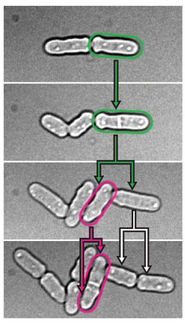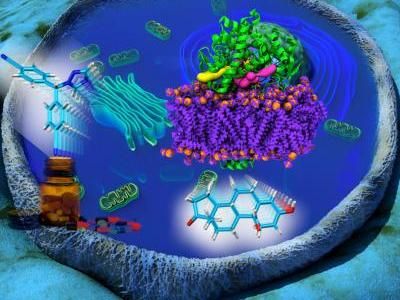New perspective for soil clean-up
Microscopic ciliates transport poisonous tar substances
Advertisement
You must use a microscope to spot the new helpers that can assist in biological soil clean-up (bioremediation). They are small, mobile microorganisms, such as the unicellular slipper-shaped ciliates that can be found in stale water in a flower vase, where they feed on bacteria. New results from Aarhus University indicate that such mobile microorganisms can play a surprising key role in bioremediation of soil which is contaminated with so-called PAHs (Polycyclic Aromatic Hydrocarbons).
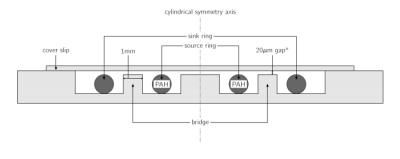
This is a cross-section of a so-called Dunn chamber with two silicone rings. The inner ring contained high concentrations of PAH, whereas the outer ring did not contain any PAH. During the experiments, the ciliates moved from the inner ring, where they absorbed the PAH, to the outer ring, where they released them. Dorothea Gilbert demonstrated this by measuring the content of PAH in the two silicone rings. *Gap heigth 10 times enlarged
Dorothea Gilbert
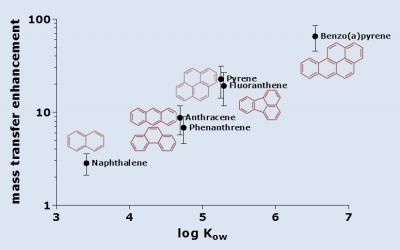
This is a cross-section of a so-called Dunn chamber with two silicone rings. The inner ring contained high concentrations of PAH, whereas the outer ring did not contain any PAH. During the experiments, the ciliates moved from the inner ring, where they absorbed the PAH, to the outer ring, where they released them. Dorothea Gilbert demonstrated this by measuring the content of PAH in the two silicone rings. *Gap heigth 10 times enlarged
Dorothea Gilbert, Aarhus University
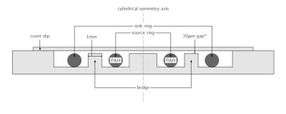
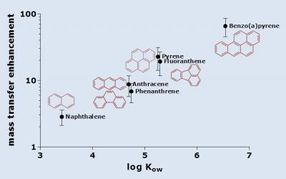
PAH are toxic tar substances formed during incomplete combustion in, for example, car engines and cigarettes. The classic PAH is benzo(a)pyrene, which was one of the first substances shown to be able to cause cancer. Until now PAHs were considered minimally mobile in soil because they bind to soil particles and only small amounts of PAH can be dissolved in water. However, the new study reveals that motile microorganisms can increase the mobility of PAHs significantly.
The experiments show that ciliates can enhance the transport of PAHs and potentially other hydrophobic chemicals up to 100-fold. This can be of great importance for the mobility and bioavailability of such substances and opens up new perspectives for cleaning PAH-contaminated soil because bioavailability is a crucial prerequisite for the biodegradation of PAHs.
First time ever
PhD student Dorothea Gilbert has been responsible for the tests with the ciliate Tetrahymena pyriformis. Together with Professor Philipp Mayer, who is presently employed at the Technical University of Denmark (DTU), she has developed a new test setup that allows exposing the ciliates to a concentration gradient while concurrently enabling their observation through a microscope in real time and measuring the transport of PAH by means of chromatographic methods.
"Until now, no one has ever It has to our knowledge not been shown before that microorganisms can actively move PAHs. Previously, we have seen that such substances can be transported passively with the water flow when they are bound to small particles, colloids or bacteria. Our experiments demonstrate that motile microorganisms such as Tetrahymena pyriformis swim actively with the PAHs, and it is important to notice that the ciliates can swim faster than PAHs can be transported by means of diffusion. This makes them very effective shuttles for PAHs on small spatial scale where there is no fluid flow.
Looking at several PAHs simultaneously, we observed that the mass transfer enhancement increased with the hydrophobicity of the PAHs. This is connected with the fact that more PAH is incorporated into the ciliates' lipid cell membrane, the more hydrophobic the PAHs" says Dorothea Gilbert.
New perspectives for soil bioremediation
These results question whether PAHs are quite as immobile in soil as has been thought until now.
"We expect that mobile microorganisms can transport PAHs in the stagnant water around and between soil particles and in water-filled pores. On such a micro-scale transport is generally based on diffusion, which for PAHs is very limited. Our study shows that mobile microorganisms can in such diffusion-limited condition increase the transport of PAHs. Our discovery can also be important with regard to bioremediation of PAH-contaminated soil.
The new findings indicate that microorganisms can increase the mobility of PAHs. By this means PAHs may become more accessible to bacteria which can degrade them, and make them more accessible to plant roots that can absorb them. Both are important prerequisites for biological treatment of PAH-contaminated soil," explains Dorothea Gilbert.
The findings have been published inl Environmental Science & Technology.



